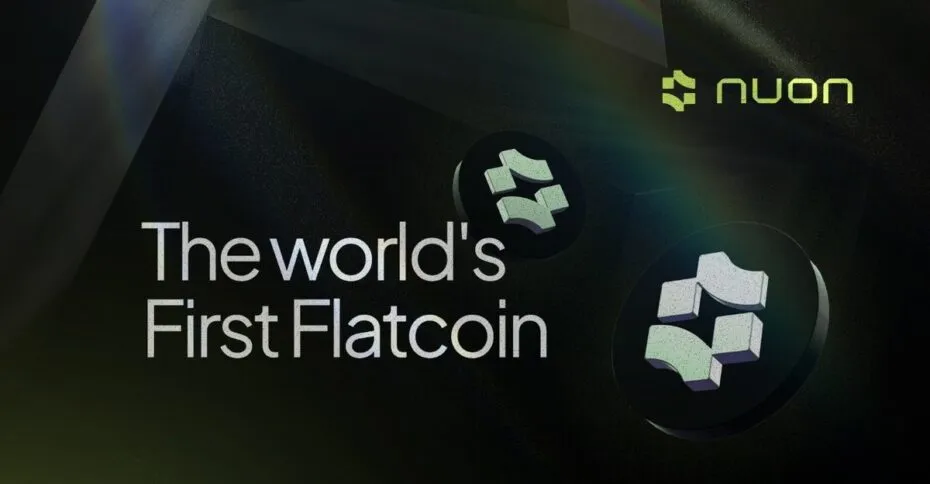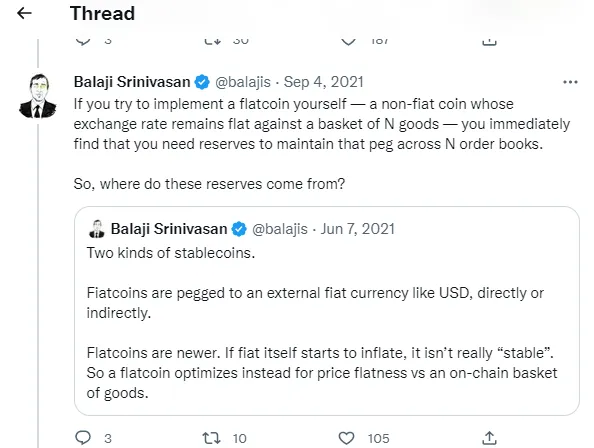By far not a new and novel concept, but "[b]lockchain tech firm Laguna Labs has launched a testnet for its in-development 'flatcoin' — a spin-off of stablecoin tokens — pegged to the cost of living rather than a fiat currency or a commodity" [Quarmby, B. Inflation-pegged ‘flatcoin’ launches testnet to track the cost of living. (Accessed October 25, 2022)].
In a press release dated October 24, 2022, Laguna Labs:
[...] has announced the launch of its testnet for Nuon: the world's first decentralized and overcollateralized "flatcoin". Frequently discussed by crypto founders like Brian Armstrong, Balaji S. Srinivasan and Vitalik Buterin, the value of flatcoin is pegged to the cost of living. Unlike most stablecoins that are pinned to depreciating assets like the US dollar, the value of a Nuon flatcoin is based on daily unbiased, authentic, and on-chain inflation data. This means a Nuon's purchasing power remains constant - or "flat" - from the moment it is bought to the moment it is sold. Users can now test the Nuon minting mechanism on the protocol's first testnet - launched to allow developers and community members to participate in the growth and development of this revolutionary new project.
[Laguna Labs. Nuon Launches Testnet For Crypto's First Flatcoin. (Accessed October 25, 2022)].
The Nuon flatcoin
[...] is the world’s first true decentralized flatcoin — a stablecoin with a price peg that rises and falls with inflation rates, shielding holders against loss of value from inflation. Current daily inflation levels are measured by Truflation, an independent inflation index oracle. Truflation calculates the Nuon peg daily and shares it with the Nuon protocol, which uses over-collateralization and arbitrage to maintain the peg while offsetting inflation for Nuon flatcoin holders. Nuon can be minted on the Nuon Protocol by depositing cryptocurrency collateral — accepted tokens include ETH, BTC, AVAX, BUSD, USDC and USDT. Nuon loans feature double-audited, open-source smart contracts, insured deposits and a zero percent interest rate for borrowers’ peace of mind. Additionally, minted Nuon is always over-collateralized to ensure the peg is stable. Nuon can also be purchased directly from exchanges. This offers anybody a quick way to hedge against inflation without having to go through the process of collateralization. This avenue is best suited to retail users, leaving the minting of fresh Nuon primarily to market makers and arbitrageurs.
[Nuon Finance. White Paper. (Accessed October 25, 2022)].
"In the face of rising global inflation and fast-depreciating fiat currencies, the concept of a flatcoin has been frequently discussed by influential blockchain founders. These include Balaji S. Srinivasan, ex-CTO of Coinbase, who in a number of Twitter threads explored the flatcoin concept as a way to avoid US dollar depreciation in stable digital assets" [Laguna Labs, supra]. This insightful twitter thread provides a wealth of information and is well worth the read, top to bottom.
"This was echoed by Ethereum founder Vitalik Buterin, who in a recent podcast stated that crypto should prepare to de-peg from overreliance on any one asset to avoid potential concentration and regulatory risks. He added that a peg against an unbiased Consumer Price Index (CPI) would be an alternative option" [Id]. This interesting podcast may be accessed by clicking here.
And finally in this regard, "[...] speaking to Tim Ferris last week, Brian Armstrong, founder of Coinbase, said: 'In the crypto economy, I think we need to have a currency that's not linked to fiat. We have USD Coin which is backed one to one by the dollar, and then we have decentralized stablecoins like DAI, but it would be nice to have a stablecoin, like a flatcoin, that is linked to purchasing power. Like, every one coin buys you a McDonald's hamburger today, and hopefully, in five years, one coin will still buy you a McDonald's hamburger." [Id]. This interview is also well worth your time and attention to view. It may be accessed by clicking here
As noted at the onset:
[...] while the concept of an inflation-linked crypto token is not new, it remains relatively untested. In April, Frax Finance launched a consumer price index-tracking (CPI) stablecoin called the Frax Price Index (FPI) that utilizes oracle data from ChainLink. Launching at around $1.02, the price hit an all-time high of $1.18 on July 19 but is down 10.6% since then to $1.05. Given the asset is less than a year old, it is hard to judge its success in beating out inflation rates until more time has passed. There is also the aptly named Inflation Hedging Coin (IHC), launched in October 2021, which utilizes a burning mechanism “based on the annual United States inflation data” and monthly CPI rate to determine the asset’s burn rate and, in theory, increase its value over time. However, a person snapping up IHC a year ago will see the value of their holdings fall as much as 96.4% as of today, according to data from CoinGecko, with IHC priced at $0.00009529 at the time of writing.
[Quarmby, supra].
"Laguna is building an inflation-proof economy. This unique ecosystem will be powered by Nuon, the world's first flatcoin whose value is pegged to the cost of living. Data for Nuon is provided by Truflation, a genre-defining, on-chain cryptographically true economic data aggregator. In addition, Laguna Labs plays host to Trusted Node, a lightning-fast, frictionless chain, and a Web3 wallet that unlocks your wealth-preserved future" [Laguna Labs, supra]

